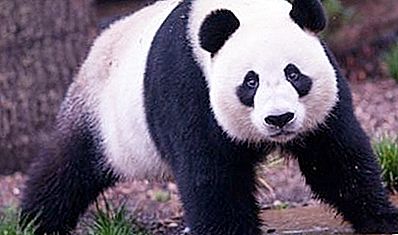Despite the fact that pandas are one of the most beloved animals, they are not safe from the devastating effects of climate change. Bamboo, almost the only source of nutrition for the endangered black and white bear, grows fast and reproduces extremely slowly. The fact that flowers and fruits appear on bamboo shoots only once every thirty to thirty-five years greatly affects its ability to adapt to changes in climatic conditions associated with global warming. Scientists warn: areas of bamboo forests in the Qinling mountains where pandas live may disappear. The area of bamboo thickets that cute bears feed on, due to climate changes, may noticeably decrease in the near future. The author of an article published in the scientific journal Nature Climate Change, devoted to changes in the climate of the planet, points out the need to create food reserves for herbivore bears.
Big pandas (photo) are the only representatives of the Bear family who feed mainly on plant foods.

The daily diet of the “vegetarian” bear consists of approximately 20 kg of bamboo. Recently, environmentalists began to notice that in some places these animals began to switch to other sources of nutrition. So, in Sichuan, there were more frequent cases when pandas climbed into pigsties and took food from their inhabitants.
A group of scientists from an American university in East Lansing (Michigan) conducted observations in the mountains of Central China, where pandas live. About a fifth of the entire population of the species lives here. Environmentalists studied the climate in the Qinling Mountains, other local factors, and also estimated the rate of decline of protected bamboo groves. The data obtained allowed researchers to develop a special climate model and make a forecast about how the most common types of bamboo will grow. The conclusions of environmentalists are not encouraging: all areas of bamboo forests in the Qinling Mountains, where pandas currently live, should disappear by the end of the 21st century.

By that time, according to environmentalists, the habitat of the bamboo bear will be reduced by about 80, or even 100 percent. Only a few highland areas will remain suitable for bamboo growth, where it is unlikely to penetrate due to the extremely slow breeding cycle. But if that happens, the big pandas will gain a chance of survival.
Lack of food will lead to forced migration of herbivorous bears to new habitats. However, cuttings and buildings between separate sections of bamboo groves will interfere with animals. It should also take into account the characteristics of the breeding of this species of bears. Little pandas are born on average once every 2-3 years.

In addition, the female feeds only one cub. Scientists at the University of Michigan insist on urgent measures to protect areas of bamboo groves where pandas live now. Environmentalists hope that the results of their research will be taken into account by the authorities of the People's Republic of China and other countries in southeast Asia when developing preventive measures to help preserve the population of large pandas.




